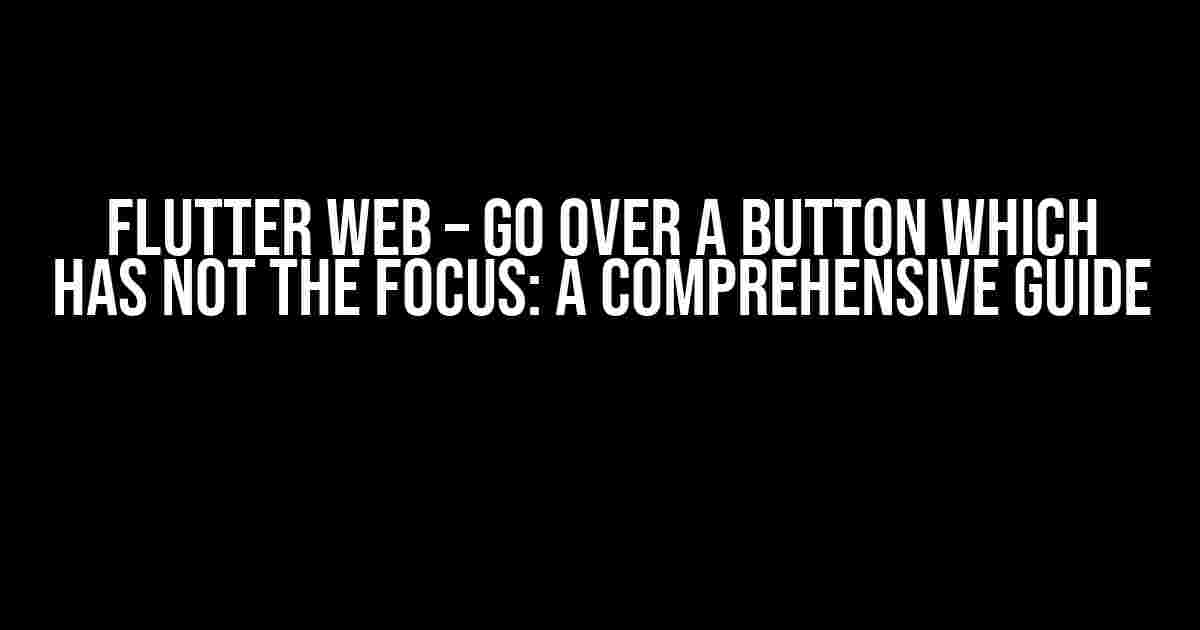Are you tired of dealing with focus issues on your Flutter Web application? Do you want to know the secret to creating a seamless user experience? Look no further! In this article, we’ll take you on a journey to explore the world of focus management in Flutter Web, specifically, how to go over a button that has not the focus. Buckle up, and let’s dive in!
Understanding Focus in Flutter Web
Before we dive into the solution, it’s essential to understand how focus works in Flutter Web. In Flutter, when a widget receives focus, it means that it’s ready to receive user input. Focus is crucial for accessibility, as it helps users navigate through your application using a keyboard or screen reader.
By default, Flutter Web uses the HTML focus model, which means that only one element can have focus at a time. When you click on a widget, it receives focus, and when you click elsewhere, the focus is lost. Simple, right?
The Problem: Going over a button that has not the focus
Now, imagine you have a button in your Flutter Web application that you want to highlight or perform an action when the user hovers over it, but the button doesn’t have focus. This is where things get tricky. By default, Flutter Web won’t allow you to go over a button that doesn’t have focus, making it challenging to create a smooth user experience.
So, how do we overcome this limitation? Fear not, dear reader, for we have a solution!
The Solution: Using MouseRegion and FocusNode
The secret to going over a button that has not the focus lies in using the `MouseRegion` widget in conjunction with a `FocusNode`. Yes, you read that right – a `FocusNode`!
Step 1: Create a FocusNode
FocusNode _focusNode = FocusNode();
Create a `FocusNode` instance and assign it to a variable. This will help us manage the focus state of our button.
Step 2: Wrap your button with MouseRegion
MouseRegion(
onHover: (_) {
// Code to execute when the user hovers over the button
},
child: RaisedButton(
focusNode: _focusNode,
onPressed: () {
// Code to execute when the button is pressed
},
child: Text('Click me!'),
),
)
Wrap your button with the `MouseRegion` widget and pass the `FocusNode` instance as the `focusNode` property of the button. This will allow us to detect when the user hovers over the button, even if it doesn’t have focus.
Step 3: Use the onHover callback
MouseRegion(
onHover: (_) {
_focusNode.requestFocus();
},
child: RaisedButton(
focusNode: _focusNode,
onPressed: () {
// Code to execute when the button is pressed
},
child: Text('Click me!'),
),
)
In the `onHover` callback, request focus on the `FocusNode` instance using `_focusNode.requestFocus()`. This will bring the focus to the button, allowing the user to interact with it.
Putting it all together
import 'package:flutter/material.dart';
void main() {
runApp(MyApp());
}
class MyApp extends StatelessWidget {
@override
Widget build(BuildContext context) {
return MaterialApp(
title: 'Flutter Demo',
home: Scaffold(
appBar: AppBar(
title: Text('Flutter Demo'),
),
body: Center(
child: MouseRegion(
onHover: (_) {
_focusNode.requestFocus();
},
child: RaisedButton(
focusNode: _focusNode,
onPressed: () {
print('Button pressed!');
},
child: Text('Click me!'),
),
),
),
),
);
}
FocusNode _focusNode = FocusNode();
}
Run the above code, and voilà! You should now be able to hover over the button and have it receive focus, even if it didn’t have focus initially.
Tips and Variations
Now that you’ve mastered the art of going over a button that has not the focus, let’s explore some additional tips and variations to take your Flutter Web application to the next level.
1. Use a separate FocusNode for each button
If you have multiple buttons that you want to highlight on hover, create a separate `FocusNode` instance for each button. This will ensure that each button receives focus independently.
2. Add a visual effect on hover
MouseRegion(
onHover: (_) {
_focusNode.requestFocus();
setState(() {
_isHovered = true;
});
},
onExit: (_) {
setState(() {
_isHovered = false;
});
},
child: RaisedButton(
focusNode: _focusNode,
onPressed: () {
// Code to execute when the button is pressed
},
child: Text('Click me!'),
color: _isHovered ? Colors.blue : Colors.grey,
),
)
Add a visual effect, such as changing the button’s color, when the user hovers over it. Use the `onHover` and `onExit` callbacks to update the state and toggle the effect.
3. Use a global FocusNode manager
If you have a complex application with multiple focusable widgets, consider using a global `FocusNode` manager to keep track of the focus state of each widget. This will help you avoid focus-related issues and improve the overall user experience.
Conclusion
And there you have it! With the power of `MouseRegion` and `FocusNode`, you can now create a seamless user experience in your Flutter Web application, even when the button doesn’t have focus initially. Remember to use a separate `FocusNode` instance for each button, add visual effects on hover, and consider using a global `FocusNode` manager for complex applications.
By following this guide, you’ll be well on your way to creating an amazing Flutter Web application that delights your users. Happy coding!
| Keyword | Description |
|---|---|
| Flutter Web | A framework for building web applications using the Flutter framework |
| FocusNode | A class that manages the focus state of a widget |
| MouseRegion | A widget that detects mouse events, such as hover and click |
- Flutter Web official documentation: https://flutter.dev/docs/get-started/web
- FocusNode API documentation: https://api.flutter.dev/flutter/widgets/FocusNode-class.html
- MouseRegion API documentation: https://api.flutter.dev/flutter/widgets/MouseRegion-class.html
By following this comprehensive guide, you’ll be able to go over a button that has not the focus in your Flutter Web application. Remember to practice and experiment with different variations to take your application to the next level.
- Master the art of focus management in Flutter Web.
- Use MouseRegion and FocusNode to detect hover events.
- Add visual effects on hover to enhance the user experience.
- Consider using a global FocusNode manager for complex applications.
Happy coding, and don’t forget to share your creations with the Flutter community!
Here are 5 Questions and Answers about “Flutter Web – Go over a button which has not the focus”:
Frequently Asked Question
Get your queries resolved about Flutter Web and navigating over buttons without focus!
Q1: How do I move the focus to a button on a Flutter web page?
You can use the `FocusNode` class in Flutter to programmatically move the focus to a specific widget, including a button. Create a `FocusNode` instance and pass it to the `focusNode` property of the button. Then, call `focusNode.requestFocus()` to move the focus to the button.
Q2: Can I use the `TabIndex` property to set the order of focus for buttons on a Flutter web page?
Yes, you can use the `TabIndex` property to set the order of focus for buttons on a Flutter web page. This property determines the order in which widgets receive focus when the user navigates using the keyboard. Simply set the `TabIndex` property to a positive integer value for each button, and the focus will move to the button with the next highest index value when the user presses the Tab key.
Q3: How do I detect when a button has received focus on a Flutter web page?
You can use the `FocusNode` class to detect when a button has received focus on a Flutter web page. Create a `FocusNode` instance and pass it to the `focusNode` property of the button. Then, listen to the `FocusNode`’s `onFocusChanged` callback to detect when the button receives focus.
Q4: Can I use CSS to style a button when it receives focus on a Flutter web page?
Yes, you can use CSS to style a button when it receives focus on a Flutter web page. Flutter web uses the `:focus` pseudo-class to style elements when they receive focus. You can define a CSS rule that targets the `:focus` pseudo-class and applies the desired styles to the button.
Q5: How do I prevent a button from receiving focus on a Flutter web page?
You can prevent a button from receiving focus on a Flutter web page by setting its `focusNode` property to `null` or by using the `IgnorePointer` widget to ignore pointer events for the button. This can be useful when you want to prevent the button from being navigated to using the keyboard.






